The official support page for the Nintendo Switch page states that dead pixels "should not be considered a defect." This particular support question is short and to the point, describing the issue and what Nintendo thinks of it:
Defective pixels (colloquially known as dead pixels) are pixels on an LCD screen that are stuck in a single color (often white or black). Typically, this issue is caused by a defective transistor that either leaves the pixel "stuck" in either color. These issues can crop up on televisions, computer monitors, phones, or any other device that uses an LCD screen.There are black or bright dots on the Nintendo Switch screen that do not go away, or there are dark or light patches on the screen.
Applies to: Nintendo SwitchSmall numbers of stuck or dead pixels are a characteristic of LCD screens. These are normal and should not be considered a defect.
Companies will often have a "dead pixel" clause in their warranty that specifies a certain threshold of dead pixels visible within a certain timeframe. For instance, a Samsung television warranty specifies the following:
13. Company accepts goods exchange for more than three dead pixels found on the LED TV / LCD TV panel within seven days from date of purchase, while company also accepts goods exchange for more than five dead pixels found on the 75" or above TV panel within seven days from date of purchase. In case of any disputes. Company reserves the right to make the final decision.Apple considers "a certain number of subpixel anomalies" as acceptable but doesn't specify any particular amount. However, a leaked 2010 document states that anywhere from 0-16 dead pixels are the guideline depending on the particular product and screen size.
Tested did a comparison of different companies and their policies on defective pixels in 2010, finding that companies had a diverse set of policies at the time. These included zero tolerance within a certain timeframe (e.g., any dead pixels within the first 30 days entitles you to repair or replacement) or a certain threshold of defective pixels within a certain timeframe. This timeframe can range from a set number of days to (presumably) the entire warranty period in the cases where a timeframe is not specified.
What makes Nintendo's policy regarding the Nintendo Switch unusual is that they do not specify any threshold of pixels for repair or replacement, much less any timeframe for effecting repairs or a replacement. This policy resulted in a nearly 2,200 comment thread on Reddit's /r/NintendoSwitch subreddit and articles on other news sites such as Gizmodo, TechTimes, and The Guardian.
Strangely, this appears to be different from their policy with the 3DS. Taking the topic as written, this means that if you get stuck with any number of defective pixels on your Nintendo Switch, you just might be out of luck for getting it repaired. Whether or not this is a deliberate change in policy or an oversight remains to be seen.
What do you think of Nintendo's policy on defective pixels? Do you think you should be able to get your Nintendo Switch repaired or replaced if you have a certain amount of dead pixels on the screen? Let us know in the comments below!






